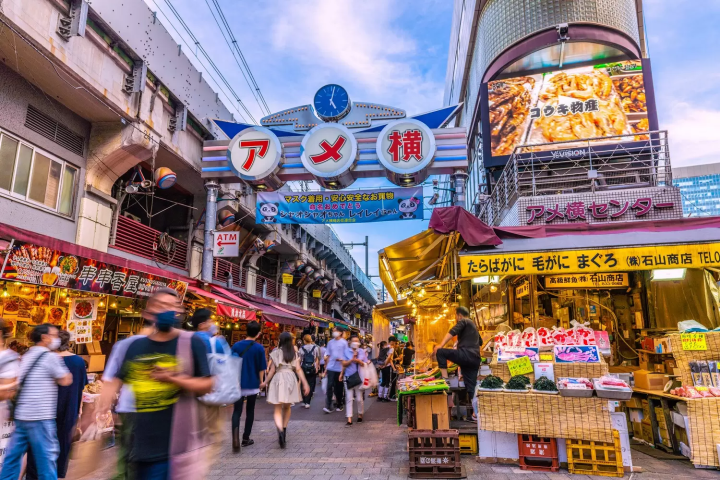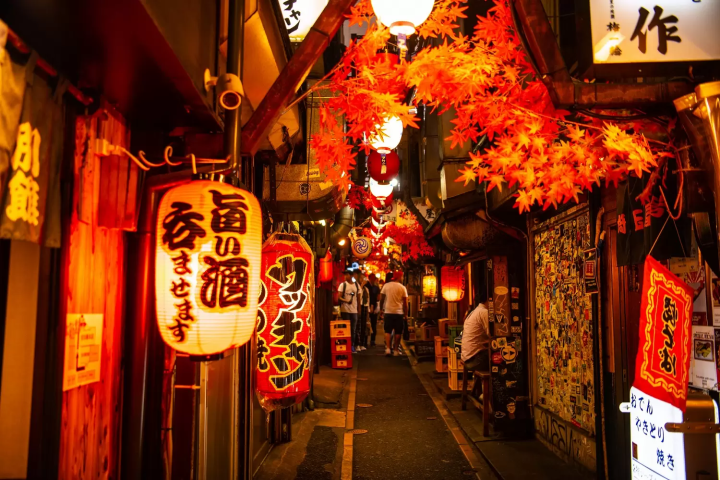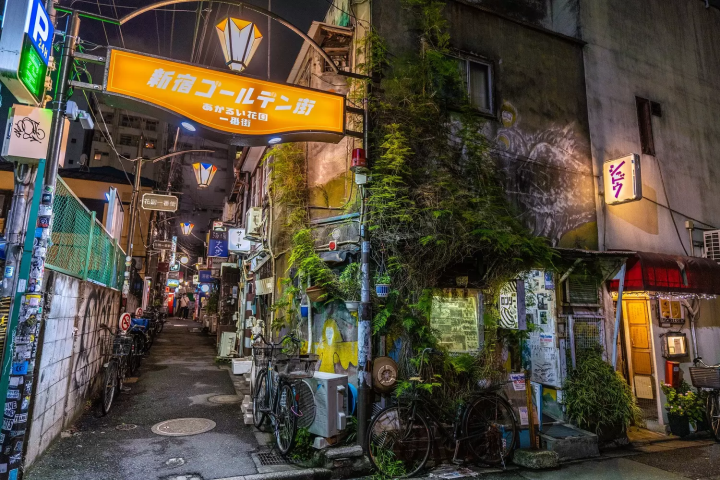Yokocho Guide: Explore Japan's Famous Drinking Alleys and Back Streets

Japan's yokocho (alleys lined with shops) have a retro charm and are appealing for their tasty food and drinks. Tokyo's Omoide Yokocho or Shinjuku Golden Gai are also loved as places where one can interact with other people. We introduce some of the famous yokocho found in Japan's major cities.
Japan's Yokocho: Drinking Alleys
Yokocho, or drinking alleys, are found throughout Japan including ones in Tokyo and Osaka.
When you visit a yokocho, not only can you go from shop to shop sampling various kinds of food and drink, but you can also experience good old-fashioned Japanese culture firsthand.
This article introduces famous yokocho alleys that are found throughout the country, so please use this as a reference when planning your next trip to Japan.
Japan's Yokocho Drinking Alleys
1. What Exactly Is a Yokocho?
2. Famous Yokocho Alleys in Tokyo
- Omoide Yokocho (Shinjuku)
- Golden Gai (Shinjuku)
- Nonbei Yokocho (Shibuya)
- Harmonica Yokocho (Kichijoji)
- Neo Yokocho
3. Famous Yokocho Alleys in Osaka
- Hozenji Yokocho (Namba)
- Janjan Yokocho (Tennoji)
4. Lido Restaurant Alley in Kyoto
5. Honobono Yokocho in Hiroshima
6. Tenjin and Nakasu Yatai Yokocho in Fukuoka
7. Sapporo Tsunagu in Hokkaido
What Exactly Is a Yokocho?

Ameya Yokocho. Photo by Pixta
A yokocho is a narrow alley or back street off the main thoroughfare, or a small space nestled under the overhead train tracks, crammed with many tiny eating and drinking establishments.
Here in the yokocho area, an out-of-the-ordinary kind of space spreads out, enveloped by an atmosphere that's reminiscent of Japan's Showa Period (1926-1989).
These small spaces are jam-packed with little shops, and as a natural result, the distance between people becomes closer. So you often see groups of customers enjoying lively conversation amongst themselves.
In recent years, neo yokocho―where a cluster of shops gather together on one floor of a building―have also been attracting plenty of attention. These shops have a reputation of being easy to enter, which is ideal for those who aren't quite used to going to an authentic yokocho.
Famous Yokocho Alleys in Tokyo
There are famous yokocho in Tokyo including ones in Shinjuku, Shibuya, and Kichijoji. They all tend to be close to the station so please try dropping into some of them.
Shinjuku: Omoide Yokocho

Photo by Pixta
Shinjuku's Omoide Yokocho was born right after the war when Tokyo got burned to the ground. Throughout its history it continued to evolve and develop by offering the local residents good food and a spot to gather and enjoy some relaxing time with each other.
Omoide Yokocho is located near the train tracks just a short walk from the West Exit of Shinjuku Station.
Even today it retains traces of a bygone Showa Era. The narrow alleys are crowded with some 60 shops, offering a variety of menu items including yakitori (grilled chicken on skewers) and motsuyaki (grilled offal on skewers).
At present, it's a popular sightseeing spot that is visited by many international travelers.
Omoide Yokocho
Location: Tokyo, Shinjuku, Nishi Shinjuku 1-2
Business Hours: Depends on the shop
Closed: Depends on the shop
Official Homepage: Omoide Yokocho
Shinjuku: Golden Gai

Photo by Pixta
Shinjuku Golden Gai, situated in Tokyo's Kabukicho area, is a bar district consisting of about 280 drinking establishments.
Each and every one of the bars is a cozy little establishment so it's considered good manners to visit in a small group.
Many unique shops line the narrow streets including izakayas, snack bars (*1), bars, and bistros. So you can visit many times to find a spot that's perfect just for you.
One of Golden Gai's appealing features is that you can enjoy new concept-style shops as well as old-fashioned shops that retain their Show Period flavor.
*1 Snack bar: a drinking establishment that provides a more intimate setting than a regular bar. Here the master or mama-san will engage in conversation with customers and make them feel welcome, creating a warm atmosphere and sense of community that often results in repeat visits.
Shinjuku Golden Gai
Location: Tokyo, Shinjuku, Kabukicho 1-1-6
Business Hours: Depends on the shop
Closed: Depends on the shop
Official Homepage: Golden Gai
Read also
Shibuya: Nonbei Yokocho
Nonbei Yokocho sits in the heart of the Shibuya area. This retro-style yokocho is home to 40 small shops crowded side by side.
Here, in a corner of a big city with rows of tall skyscrapers and nearby Miyashita Park, visitors can experience a deep hidden gem that feels just like you've gone back to the good old days of the Showa Era.
This yokocho features a variety of different shops, from izakayas and yakitori shops all the way to places serving up home-style cooking.
Nonbei Yokocho
Location: Tokyo, Shibuya 1-5
Business Hours: Depends on the shop
Closed: Depends on the shop
Official Homepage: Nonbei Yokocho
Read also
Kichijoji: Harmonica Yokocho

Photo by Pixta
Harmonica Yokocho is located right across from the North Exit of Kichijoji Station.
More than 100 small shops line the network of intricate narrow alleys which are always lively and full of energy.
Along this yokocho with its international flavor you can enjoy many kinds of cuisine including Vietnamese pho soup, shoronpo (a kind of Chinese soup dumpling), and other Asian dishes, as well as sushi and ramen.
There are also eating spots offering authentic roasted chicken (takeout available), satsuma-age(deep-fried fish paste), and taiyaki (pastry filled with red bean paste). So when you're feeling a little hungry you can easily drop in for a small bite.
Harmonica Yokocho
Location: Tokyo, Musashino, Kichijoji-honcho 1-1
Business Hours: Depends on the shop
Closed: Depends on the shop
Official Homepage: Harmonica Yokocho (Japanese)
Read also
Neo Yokocho: A New Kind of Gathering Spot
Neo Yokocho, which features a wide variety of dining spots clustered in one space, has become extremely popular. The reason for its popularity is due to the space's interior which incorporates photo-worthy Showa Era-nuances, and the fact that it's so easy to go from shop to shop and sample all the delicious food and drink.
So let's check out the two Neo Yokocho in Tokyo.
1. Toranomon Yokocho: Inside Toranomon Hills Building
Toranomon Yokocho is located on the third floor of the Toranomon Hills Business Tower. Here there are 26 famous restaurants from all parts of Tokyo in one spot.
Visitors can purchase some wine at Toranomon Yokocho Cellar, and then enjoy it on the restaurant premises. So it'll also be fun to find menu items that pair well with the wine you've selected.
Toranomon Yokocho
Location: Tokyo, Minato, Toranomon 1-17-1
Business Hours: 11:00 - 23:00 (Hours can differ depending on the shop)
Closed: Depends on the shop
Official Homepage: Toranomon Yokocho
2. Shibuya Niku Yokocho: Inside Chitose Kaikan
Shops at Shibuya Niku Yokocho offer a variety of cuisines, all based on the theme of meat.
The 28 shops serve a wide range of different dishes including meat sushi using wagyu beef, Japanese black wagyu beef served yakiniku style, as well as yakitori and Japanese-style cuisine.
Shibuya Niku Yokocho
Location: Tokyo, Shibuya, Udagawacho Chitose Kaikan 2F & 3F
Business Hours: Depends on the shop
Closed: Depends on the shop
Official Homepage: Shibuya Niku Yokocho
Famous Yokocho in Osaka That We Recommend
Osaka's famous yokocho are found in such areas as Namba and Tennoji, known for being entertainment districts. These are spots where you can casually experience sake together with Osaka's culinary specialties, so please try visiting some of them.
Namba: Hozenji Yokocho

Photo by Pixta
Hozenji Yokocho is located in an entertainment district in Osaka's Minami area. This yokocho has a calm, adult kind of atmosphere.
This spot was originally the precincts for the Jodo sect temple of Tenryu-san Hozenji. The street stalls that catered to the temple worshippers eventually developed into this present-day yokocho.
In this refined yokocho with its impressive cobblestone streets, visitors can savor Osaka specialties including okonomiyaki and kushi katsu (deep-fried skewers with meat and vegetables).
Hozenji Yokocho
Location: Osaka, Osaka, Chuo, near Namba 1-chome
Business Hours: Depends on the shop
Closed: Depends on the shop
Tennoji: Janjan Yokocho (Nanyodori Shopping Street)
The official name for Janjan Yokocho is the Nanyodori Shopping Street. It's located in Shinsekai, the home turf for Osaka's symbolic Tower, Tsutenkaku.
This appealing yokocho has a retro-style atmosphere. Visitors here can enjoy Osaka's specialty B-kyu Gourmet (*2) including takoyaki, okonomiyaki, and kushi katsu. There are also shops where you can try refined sake (seishu) and nigirizushi (small oval-shaped rice ball topped with fish or other ingredients).
*2 B-kyu Gourmet: refers to simple and hearty food that's popular with the masses. B-kyu means "second rank" in English. Typical examples are yakisoba, curry rice, and omelette rice (omurice).
Janjan Yokocho
Location: Osaka, Osaka, Naniwa, near Ebisu Higashi 3-chome
Business Hours: Depends on the shop
Closed: Depends on the shop
Lido Restaurant Alley in Kyoto: A Hidden Gem!
When you feel like going for a light drink after an enjoyable day of Kyoto sightseeing, we highly recommend Lido Restaurant Alley, just a five-minute walk from Kyoto Station. The alley is lined with various shops selling such menu items as obanzai (*3), tempura, and offal-yaki.
If you're someone who'd like to enjoy the special mood created by this "Showa Era neon town," or someone who wants to interact with the local residents, then by all means this is the place to be.
*3 Obanzai: a traditional style of Japanese home-style cooking that's native to Kyoto. It relies heavily on locally sourced vegetables and seafood prepared in a simple manner.
Lido Restaurant Alley
Location: Kyoto, Kyoto, Shimogyo, Higashi Sakaicho 180
Business Hours: Depends on the shop
Closed: Depends on the shop
Honobono Yokocho in Hiroshima
Honobono Yokocho is a bar district featuring top-notch eating and drinking establishments with a Showa-era retro atmosphere.
If you sign up for Hashigozake (bar-hopping), you can enjoy all-you-can-drink privileges (specified drinks only) at any of the shops in the yokocho for an unlimited time. The cost after tax is 2,200 yen for men and 1,100 yen for women.
As you stop into shops selling yakitori, kushi nikomi, tempura, and sushi, you can also enjoy draft beer, shochu (distilled spirits) and liqueur to your heart's content!
Honobono Yokocho
Location: Hiroshima, Minami, Matsubaracho 10-1, Hiroshima Full Focus Building 5F
Business Hours: Monday - Friday 16:00 - 23:30 *Last order (food) is 23:00, (drink) 23:15.
Sat., Sun., public holidays 14:00 - 23:30 *Last order (food) is 23:00, (drink) 23:15.
Closed: Open every day
Official Homepage: Honobono Yokocho
Tenjin and Nakasu Yatai Yokocho: Enjoy Fukuoka Cuisine
If you'd like to go bar-hopping in Fukuoka City―where the culture of food stalls (yatai) is flourishing―then we recommend the food stall areas of Tenjin and Nakasu. Visitors can try a variety of local specialties that include Hakata ramen and Hakata pork belly yakitori (buta bara).
Tenjin: Yatai District
The Tenjin district is known for having about half of all the food stalls within Fukuoka City. The yatai are located along major streets such as Showa-dori Avenue near Nishitetsu Fukuoka (Tenjin) Station and also in front of Daimaru Department Store (Fukuoka-Tenjin location).
The food stalls in the Tenjin area attract a relatively high number of Fukuoka residents. So among this relaxed atmosphere you can enjoy your favorite beverage together with Hakata culinary specialties. This is perfect for those who want to interact with the locals.
Tenjin Area Yatai District
Location: Fukuoka, Fukuoka, Chuo, near Tenjin
Business Hours: Depends on the shop
Closed: Depends on the shop
Nakasu: Yatai District
Fukuoka City's Nakasu area sits alongside the Nakagawa River. Food stalls are set up near Canal City Hakata and along Showa-dori Avenue on the east side of the Nakagawa River.
The Nakasu Yatai District, which has many old-fashioned food stalls, attracts plenty of sightseeing visitors and is always bustling with activity.
So if you want to enjoy a lively atmosphere then please stop in and give it a try.
Nakasu Area Yatai District
Location: Fukuoka, Fukuoka, Hakata, near Nakasu
Business Hours: Depends on the shop
Closed: Depends on the shop
Sapporo Tsunagu: Hokkaido's Favorite Yokocho
Sapporo Tsunagu Yokocho features a variety of unique shops all on one floor. It's only seven minutes on foot from Sapporo Station.
From izakaya serving fresh seafood dishes all the way to local Chinese eateries, the shops here are unique and full of character.
Many yokocho in Japan have a cash-only policy, but here at Sapporo Tsunagu Yokocho they also accept credit cards and e-money. So it's not a problem if you feel like dropping in on the spur of the moment.
Sapporo Tsunagu Yokocho
Location: Hokkaido, Sapporo, Kita, Kita 6-jo, Nishi 6-chome, WEST 6, under JR Sapporo Station's West Exit Overpass, 2F
Business Hours: Monday to Saturday 17:00 - 24:00
Closed: Sundays (May change due to events and national holidays)
Official Homepage: Sapporo Tsunagu Yokocho (Japanese)
Spend Some Fun Time at Your Favorite Yokocho!
A yokocho―where adventure seekers can bask in a nostalgic glow―allows you to easily go from shop to shop depending on your mood.
A Yokocho also gets alot of attention as a sightseeing spot. So how about stopping in for a special experience that's not possible anywhere else?
Read also
Written by Cakutama editorial team
Main image by Pixta
This is the official account of MATCHA's editorial department. Our articles feature useful travel information for visitors to Japan, from how-to guides to recommended places to visit.













































![[2026] Top 5 Strawberry Picking Spots in Tokushima, Naruto| Farms and Access Guide for January to May](https://resources.matcha-jp.com/resize/720x2000/2025/03/06-227165.webp)



